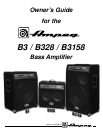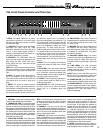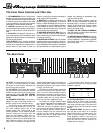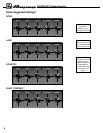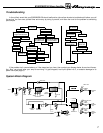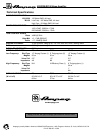
4
The Front Panel Controls and Their Use
The Rear Panel
CAUTION
RISK OF ELECTRIC SHOCK
DO NOT OPEN
AVIS:
WARNING:
TO REDUCE THE RISK OF FIRE OR
ELECTRIC SHOCK, SO NO EXPOSE THIS EQUIP-
MENT TO RAIN OR MOISTURE.
RISQUE DE CHOC ELECTRIQUE
NE PAS OUVRIR
SPEAKERS
EFFECTS
LOOP
BAL.
OUT
FOOT
SWITCH
RETURN SEND
HIGH
50 WATTS
@8 OHMS
8 OHM MIN.
LOW
100 WATTS
@4 OHMS
4 OHM MIN.
MODEL
SERIAL #
B-3158
500 WATTS MAX.
115VAC-60Hz
POST
PRE
-20dB
0dB
18 19 20 23 2421 2216 17
FOR 100-120VAC, 50/60Hz: T5A, 250V
FOR 220-240VAC, 50/60Hz: T2.5A, 250V
16. FUSE: This protects the unit from dam-
age due to overload conditions or power
line surges. In case of failure, replace it only
with the same size and type.
17. AC LINE IN: Firmly insert the supplied
AC power cord into this socket until it is fully
seated. Plug the male end of the cord into a
grounded AC outlet. DO NOT DEFEAT
THE GROUND PRONG OF THE AC
PLUG!
18. SPEAKER OUTPUT(S): This section is
different for each of the three models. The
B3158 is shown in the illustration above.
The B3158 has two internal amplifiers,
one for the high frequencies, one for the
low. Each amplifier section has its own
speaker output jack, factory-wired to the
internal speakers. To use external speaker
cabinets, unplug the connectors from the
jacks and use speaker cables with 1/4”
plugs to connect the LOW jack to your low
frequency cabinet and the HIGH jack to the
high frequency cabinet. Use the Balance
control (#12, front panel) to proportion the
output signal between the low and high fre-
quency output jacks. Observe the minimum
impedance ratings for each output (8 ohms
for high, 4 ohms for low).
The B3 has a single speaker output jack
(wired at the factory to its speaker enclo-
sure). To use an external speaker cabinet,
disconnect the amplifier from the enclosure
and connect it to the external cabinet, using
a speaker cable with 1/4” plugs. Observe
the 4 ohm minimum impedance rating.
The B328 has a single speaker output
jack, and two input jacks on its speaker cab-
inet: WITH TWEETER and WITHOUT
TWEETER. Connect the speaker cable to
the jack which gives you the best sound. To
use an external speaker cabinet, discon-
nect the amplifier from the enclosure and
connect it to the external cabinet, using a
speaker cable with 1/4” plugs. Observe the
4 ohm minimum impedance rating.
The following chart shows the total
impedance load when connecting speaker
cabinets in parallel:
Cabinet # of Total
Impedance Cabs Impedance
8Ω 24Ω
16Ω 28Ω
16Ω 44Ω
19. EFFECTS RETURN: To use an external
effects device or other signal processor,
connect the OUTPUT of the device to this
jack using a shielded cable. This returns the
processed signal into the amplifier’s master
section.
20. EFFECTS SEND: Connect the output
from this jack to the INPUT of an external
effects device using a shielded cable. This
sends a post-EQ signal to your effects.
Since plugging a cable in here does not
break the through connection to the power
amp, this jack can also be used as an
unbalanced line out jack.
B3/B328/B3158 Bass Amplifier
7. ULTRA-MEDIANOS: Este es el control primor-
dial para el rango de las frecuencias medianas. Gire
el control del centro hacia la izquierda para lograr
un sonido de contorno (más distante, menor salida
en el rango mediano) ó del centro hacia la derecha
para obtener un sonido realmente penetrante.
8. AGUDOS: Esta perilla sirve como el control pri-
mordial para las frecuencias altas. Esto permite un
rango de 17dB de refuerzo ó 22dB de recorte a
5kHz.
9. EQ EN LED: Este dÌodo LED indicador se ilu-
mina cuando usted activa el EQ mediante el control
Maestro (#14) del panel delantero ó el interruptor de
pie (#24) del panel posterior.
10. EQ GRAFICO: Estos controles deslizantes
(cursores) le permiten ajustar la salida de las fre-
cuencias que se muestran junto a cada control. La
posición central de cada control es plana (sin
refuerzo ni recorte). Estos controles sólo afectan el
sonido cuando el EQ esé prendido.
11. MAESTRO: Fije mediante este control el nivel
general de salida del amplificador. El Circuito de
Efectos y la Salida Equilibrada (#19, 20, 23) no se
verán afectadas por el control Maestro. Jalando el
control Maestro se prende el EQ Gráfico (#10).
Cuando se utiliza el interruptor de pie, se pasa por
alto el interruptor del panel delantero.
12. EQUILIBRIO (SOLO EN EL B358): Este con-
trol varía el nivel de la señal entre las salidas de
bajas y altas frecuencias (véase el #18) para ade-
cuar aún más el sonido).
13. DIODOS LED DE LIMITE: Este LED indicador
parpadeará cada vez que se requiera el circuito lim-
itador interno para conservar limpia la señal de sal-
ida del amplificador. Esto indica que el amplificador
está aproximándose a su salida máxima y que el
limitador está impidiendo el aplanamiento (“clip-
ping”) de la señal de salida.
NOTA: Hay dos circuitos Limitadores dentro del
B3158: uno para su amplificador de potencia de
frecuencias bajas y otro para su amplificador de
potencia de frecuencias altas. Todos los demás
modelos tienen un solo circuito Limitador, y por lo
tanto un solo LED de Limite.
14. DIODO LED DE POTENCIA ENCENDIDA:
Este LED indicador se ilumina cuando se prende el
interruptor de Potencia (#15).
15. INTERRUPTOR DE POTENCIA: Este interrup-
tor de servicio pesado tipo vaivén aplica la energía
de CA al amplificador: el amplificador se PRENDE
en la posición hacia arriba (“I”), y se APAGA en la
posición hacia abajo



